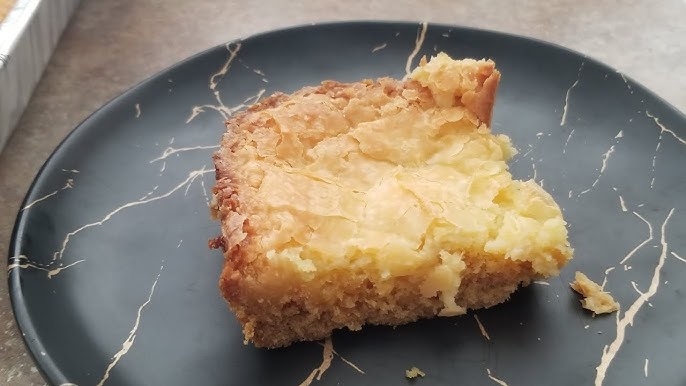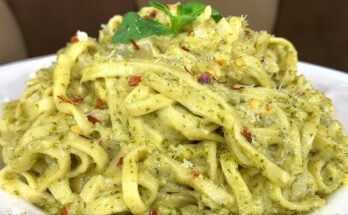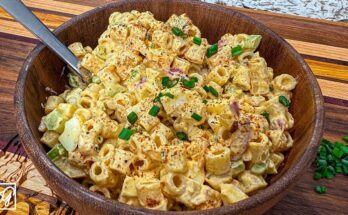Chess Squares Recipe: Few desserts hit the sweet spot quite like Chess Squares. With their buttery crust and rich, creamy filling, these simple yet indulgent treats have earned a spot in Southern kitchens and beyond. Whether you’re baking for a family gathering, a potluck, or simply to satisfy your sweet tooth, this guide will walk you through every detail of making perfect chess squares at home.
What Are Chess Squares?
Chess Squares are a classic Southern dessert made with a rich, buttery base topped with a sweet and creamy filling. Think of them as a simplified version of chess pie, but cut into neat little squares that are easy to share. The bottom layer is usually made from a cake mix or scratch-made crust, while the top is a gooey, custard-like mixture of cream cheese, sugar, and eggs. The result? A dessert bar that’s crispy on the edges, soft in the middle, and absolutely irresistible.
Why This Recipe Is So Popular?
One reason people love chess squares is their simplicity. You don’t need fancy equipment or a long list of ingredients—just pantry staples and a baking pan. They’re also incredibly versatile. You can stick with the traditional version or dress them up with chocolate, nuts, or citrus for a twist. And since they’re baked in one pan and cut into squares, they’re easy to transport, making them perfect for church events, bake sales, or family reunions.
When to Serve Chess Squares?
The beauty of chess squares is that they fit just about any occasion. Serve them warm with a scoop of vanilla ice cream for a cozy dessert. Pack them into lunchboxes for a sweet midday surprise. Arrange them on a platter for holiday gatherings, or simply enjoy them with a cup of coffee. They’re the kind of dessert that feels at home at both casual and formal events, making them a true kitchen staple.
Ingredients You’ll Need
Basic Ingredients for the Crust
The crust of chess squares forms the buttery, slightly firm base that holds the creamy topping. Traditionally, a yellow cake mix is used, which gives both convenience and flavor. If you prefer to make it from scratch, flour, sugar, and butter can be substituted. Here’s what you’ll need:
- 1 box yellow cake mix (or 2 cups flour + 1 cup sugar as a substitute)
- 1/2 cup melted butter
- 1 large egg
This mixture creates a soft yet structured base that perfectly complements the filling.
Sweet and Creamy Filling Essentials
The filling is what makes chess squares irresistible. It’s sweet, smooth, and rich, almost like cheesecake but denser. These are the essentials:
- 1 package (8 oz) cream cheese, softened
- 2 large eggs
- 1 box powdered sugar (about 3 1/2 cups)
The cream cheese provides tanginess, while the sugar adds sweetness and helps the filling set during baking. The eggs bring everything together into a luscious, custardy layer.
Optional Add-ins and Variations
Want to put your own twist on the recipe? Here are some optional ingredients to enhance your chess squares:
- Vanilla extract – Adds depth to the flavor.
- Chocolate chips – For a richer, dessert-bar vibe.
- Lemon zest – Brightens up the sweetness with a citrusy kick.
- Chopped pecans or walnuts – Add crunch and nutty flavor.
- Cinnamon or nutmeg – For a warm, spiced variation.
Whether you keep it traditional or experiment with add-ins, these ingredients ensure your chess squares are anything but boring.
Step-by-Step Guide to Making Chess Squares
Step 1 – Preparing Your Baking Pan
Before mixing anything, you need to set up your pan. Use a 9×13-inch baking dish for the perfect thickness. Grease it lightly with butter or non-stick spray, or line it with parchment paper for easy removal. This step is crucial—nobody wants their delicious dessert stuck to the bottom of the pan.
If you plan on serving them at a gathering, parchment paper is your best bet. You can lift the entire dessert out once cooled, making it easier to cut into even squares.
Step 2 – Mixing the Crust Layer
In a large mixing bowl, combine the cake mix, melted butter, and one egg. Stir until the mixture forms a dough-like consistency. It should be thick but spreadable. Press this mixture evenly into the bottom of your prepared pan, making sure it reaches the corners.
This crust forms the solid foundation of your chess squares. If it’s too thick in one spot and too thin in another, the filling won’t bake evenly—so take your time smoothing it out.
Step 3 – Creating the Creamy Filling
Next comes the star of the show: the gooey filling. In another bowl, beat the softened cream cheese until smooth. Add the eggs one at a time, mixing well after each. Gradually add the powdered sugar, mixing until the batter is creamy and lump-free.
Pour this filling over the crust, spreading it evenly with a spatula. Don’t worry if it looks a little thick—it will spread and settle during baking.
Step 4 – Layering and Baking
Bake your chess squares in a preheated oven at 350°F (175°C) for about 35–40 minutes. The edges should be golden brown, and the center should look set but slightly gooey. Don’t overbake—chess squares are meant to be rich and moist, not dry.
Pro tip: If the top starts browning too quickly, cover loosely with foil during the last 10 minutes of baking.
Step 5 – Cooling and Cutting into Squares
Once baked, remove the pan from the oven and let it cool completely before cutting. This cooling step allows the filling to firm up, making it easier to slice into neat squares. Use a sharp knife for clean cuts, and wipe the blade between slices if necessary.
Cut into 2-inch squares for a generous serving, or smaller bite-sized pieces if serving a crowd. Either way, you’ll end up with golden, gooey bars that disappear fast.
Tips for Perfect Chess Squares Every Time
Common Mistakes to Avoid
Even though chess squares are easy to make, there are a few pitfalls that can trip up bakers. The first mistake is overmixing the crust. Once you combine the cake mix, butter, and egg, stop mixing when it comes together into a dough. Overworking the dough makes the crust tough instead of tender.
Another common issue is overbaking. Remember, chess squares are supposed to be gooey. If you wait until the middle looks fully firm before taking them out of the oven, they’ll end up dry. Instead, remove them when the center is just slightly jiggly—the filling will set as it cools.
The last mistake is cutting too soon. It’s tempting to dig in right away, but slicing while warm will make the filling ooze everywhere. Let them cool completely before cutting if you want neat, bakery-style squares.
How to Get the Perfect Texture
The texture of chess squares is what makes them special—soft, gooey, and slightly chewy all at once. To achieve this, make sure your cream cheese is fully softened before mixing. Cold cream cheese creates lumps in the filling.
Also, sift the powdered sugar before adding it to the filling. This prevents clumps and ensures a silky-smooth batter. If you want extra richness, try adding a splash of heavy cream or a teaspoon of vanilla extract to the filling. These little touches make a big difference.
Lastly, pay attention to oven placement. Bake your chess squares on the middle rack so the heat circulates evenly. Too close to the top and the filling may brown too quickly; too close to the bottom and the crust can overcook.
Storage and Serving Suggestions
Once cooled and cut, chess squares can be stored in an airtight container at room temperature for up to 3 days. If you want them to last longer, refrigerate them for up to a week. They taste just as delicious chilled, especially on a warm day.
For serving, you can dust the top with a little powdered sugar for an elegant touch. If you’re making them for a party, arrange them on a platter with parchment squares between layers to prevent sticking. They pair beautifully with coffee, tea, or even a cold glass of milk.
If you want to take them to the next level, serve warm chess squares with a scoop of vanilla ice cream or a drizzle of chocolate sauce. Simple, decadent, and guaranteed to impress.
Variations of Chess Squares
Chocolate Chess Squares
If you’re a chocolate lover, this twist will be your new favorite. Swap the yellow cake mix for a chocolate cake mix to create a rich cocoa crust. For the filling, you can add 2 tablespoons of cocoa powder or even fold in chocolate chips before baking. The result is a fudgy, brownie-like dessert with the same gooey texture that makes chess squares irresistible.
For an extra indulgence, drizzle melted chocolate over the cooled bars or sprinkle mini chocolate chips on top right before baking. Chocolate chess squares are perfect for birthdays, potlucks, or anytime you need a chocolate fix.
Lemon Chess Squares
For a refreshing twist, lemon chess squares bring a tangy brightness to the sweet dessert. To make them, use lemon cake mix for the crust or add 1 tablespoon of lemon zest and 2 tablespoons of lemon juice to the filling. The citrus flavor balances out the richness and gives the bars a light, sunny vibe.
Dust the top with powdered sugar and serve with fresh berries for a beautiful presentation. These are especially popular during spring and summer gatherings when lighter desserts shine.
Nutty Chess Squares
If you love crunch, nuts are a fantastic addition. Simply sprinkle chopped pecans, walnuts, or almonds over the filling before baking. The nuts add texture and a toasted flavor that pairs beautifully with the creamy filling.
For a Southern-inspired variation, try adding pecans and a drizzle of caramel sauce after baking. It’s like pecan pie meets cheesecake—decadent and delicious.
Holiday-Inspired Versions
Chess squares are versatile enough to adapt to any season. For fall, add a teaspoon of pumpkin spice to the filling or swirl in pumpkin puree for a festive twist. Around Christmas, you can use a red velvet cake mix for the crust and top the squares with crushed peppermint candy.
These themed variations not only taste amazing but also make your dessert table look festive and inviting. Plus, they’re a fun way to reinvent a classic recipe for different occasions.
Nutritional Information
Calories and Serving Size
Like most desserts, chess squares aren’t exactly light—but they’re worth every bite. On average, one 2-inch square contains around 250–300 calories, depending on portion size and add-ins. Each serving typically has about:
- Fat: 12–15 grams
- Carbohydrates: 30–35 grams
- Protein: 3–4 grams
Keep in mind that variations with chocolate, nuts, or extra toppings will increase the calorie count.
Healthier Alternatives
If you’d like a lighter version, there are a few swaps you can make without sacrificing flavor:
- Use reduced-fat cream cheese instead of full-fat.
- Replace part of the powdered sugar with a sugar substitute like Stevia or monk fruit sweetener.
- Swap the butter in the crust for coconut oil for a slightly healthier fat option.
- Add oats or almond flour to the crust for more fiber.
These tweaks won’t turn chess squares into health food, but they can make them a little more waistline-friendly while keeping the gooey goodness intact.
FAQs about Chess Squares Recipe
1. Can I make chess squares ahead of time?
Yes! Chess squares are perfect for making ahead. You can bake them a day or two in advance and store them in an airtight container at room temperature or in the fridge. They actually taste even better the next day because the flavors have time to blend.
2. How long do chess squares last?
At room temperature, chess squares last about 3 days if kept in an airtight container. In the refrigerator, they can stay fresh for up to a week. If you want to extend their shelf life even more, freezing is also an option.
3. Can I freeze chess squares?
Absolutely. Once cooled and cut, wrap individual squares tightly in plastic wrap or parchment paper, then store them in a freezer-safe bag or container. They can be frozen for up to 2 months. When ready to eat, let them thaw at room temperature or warm them slightly in the microwave.
4. What’s the difference between chess squares and chess pie?
Both desserts share similar flavors, but chess pie is baked in a pie crust, while chess squares are baked in a rectangular pan and cut into bars. The pie tends to be a bit more custardy, while chess squares lean toward the gooey, cake-bar texture.
5. Can I make them gluten-free?
Yes, you can easily make gluten-free chess squares by using a gluten-free cake mix for the crust. The filling is naturally gluten-free since it’s made with cream cheese, eggs, and powdered sugar. Just make sure all your ingredients are certified gluten-free if serving someone with celiac disease or severe gluten intolerance.
Conclusion
What makes chess squares truly special is their versatility. You can serve them warm with ice cream, dust them with powdered sugar for an elegant finish, or pack them into lunchboxes for a sweet surprise. They’re also forgiving to make, which means even beginner bakers can pull them off with ease.
The best part? These bars bring people together. From family gatherings to potlucks, bake sales, and holiday parties, chess squares are the kind of dessert that disappears fast—leaving behind happy smiles and requests for seconds. Once you’ve tried making them, they’ll likely become one of your go-to recipes whenever you need something delicious, easy, and unforgettable.



